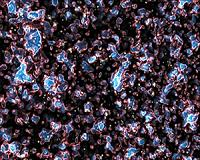 |
Rohnert Park CA (SPX) Oct 26, 2010 Astronomers in Japan, using an X-ray detector on the International Space Station, and at Penn State University, using NASA's Swift space observatory, are announcing the discovery of an object newly emitting X-rays, which previously had been hidden inside our Milky Way galaxy in the constellation Centaurus. The binary system was revealed recently when an instrument on the International Space Station named MAXI (Monitor of All-Sky X-ray Image) on the Exposed Facility of the Japanese Experiment Module "Kibo" caught it in the act of erupting with a massive blast of X-rays known as an X-ray nova. The MAXI mission team quickly alerted astronomers worldwide to the discovery of the new X-ray source at 2:00 a.m. EDT on Wednesday, 20 October, and NASA's Swift Observatory quickly conducted an urgent "target-of-opportunity" observation nine hours later, which allowed for the location of the X-ray nova to be measured accurately. "The collaboration between the MAXI and Swift teams allowed us to quickly and accurately identify this new object," said Jamie Kennea, the Swift X-ray Telescope instrument scientist at Penn State University who is leading the Swift analysis. "MAXI and Swift's abilities are uniquely complementary, and in this case have provided a discovery that would not have been possible without combining the knowledge obtained from both." The Swift detection confirmed the presence of the previously unknown bright X-ray source, which was named MAXI J1409-619. "The Swift observation suggests that this source is probably a neutron star or a black hole with a massive companion star located at a distance of a few tens of thousands of light-years from Earth in the Milky Way," said David Burrows, professor of astronomy and astrophysics at Penn State and the lead scientist for Swift's X-ray Telescope. "The contribution of Swift's X-ray Telescope to this discovery is that it can swing into position rapidly to focus on a particular point in the sky and it can image the sky with high sensitivity and high spatial resolution." "MAXI has demonstrated its capability to discover X-ray novae at great distances," said Kazutaka Yamaoka, assistant professor at Aoyama Gakuin University and a member of the MAXI team. "The MAXI team is planning further coordinated observations with NASA satellites to reveal the identity of this source." Seeing and Exploring the Universe
Share This Article With Planet Earth
Related Links The Universe at Sonoma Stellar Chemistry, The Universe And All Within It
 Beyond The Fog Of Time Most Distant Galaxy Ever Unvieled
Beyond The Fog Of Time Most Distant Galaxy Ever UnvieledParis, France (ESO) Oct 21, 2010 A European team of astronomers led by Paris Observatory CNRS Director of Research Matthew Lehnert using ESO's Very Large Telescope (VLT) has measured the distance to the most remote galaxy so far. By carefully analyzing the very faint glow of the galaxy they have found that they are seeing it when the Universe was only about 600 million years old (a redshift of 8.6), or 4.4% of its present age o ... read more |
|
| The content herein, unless otherwise known to be public domain, are Copyright 1995-2010 - SpaceDaily. AFP and UPI Wire Stories are copyright Agence France-Presse and United Press International. ESA Portal Reports are copyright European Space Agency. All NASA sourced material is public domain. Additional copyrights may apply in whole or part to other bona fide parties. Advertising does not imply endorsement,agreement or approval of any opinions, statements or information provided by SpaceDaily on any Web page published or hosted by SpaceDaily. Privacy Statement |